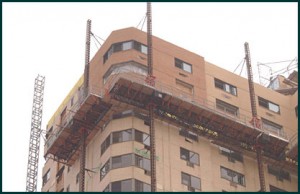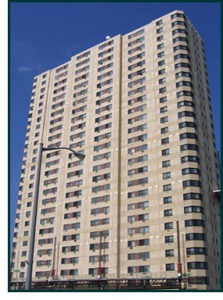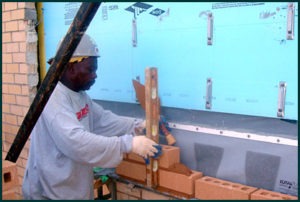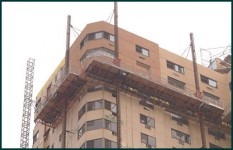REHAB & RESTORATION
CASE STUDY: Flashing
Slashing labor costs; boosting moisture protection
By Michael Trunko

Asbury Tower is a 26-story, affordable housing community for seniors. The 35-year-old facility has 347 apartments and is located on the ocean in Asbury Park, N.J. While the building was structurally sound, sections of the brick facade had begun falling off.
LAN Associates, Engineering, Planning, Architecture, Surveying Inc., based in Midland Park, N.J., has been retained to reengineer the skin and spec out the project. The project also includes mechanical upgrades to air conditioning and sprinkler systems as well as interior upgrades, including new kitchens and bathrooms.
The principal-in-charge and architect-of-record is Kenneth Karle, AIA, PE, and president of LAN Associates. LAN services federal, state, county and municipal governments; housing authorities; boards of education; Fortune 500 companies; foreign companies and private clients.
Blade Contracting, of Staten Island, N.Y., is the masonry contractor. The company specializes in brick, block and waterproofing of new construction, high rises, and restoration work.
After scaffolding the entire building, the brick on each floor is being removed and then replaced.
“The demolition was the real challenge,” says James Lerie, VP of Blade Contracting. “On new construction, we start from the bottom and work our way up. This job’s different. We’re going from the top down, and it’s a challenge. It’s harder than other projects.”
Faced with time constraints and a structure subjected to severe ocean weather, LAN specified Mortar Net’s TotalFlash for cavity wall drainage. The pre-assembled panels of flexible flashing and drainage components are designed specifically to control moisture in masonry construction.

“We saw an ad for TotalFlash in a trade publication and requested information for this project,” says Vlad Potiyevsky, project architect with LAN. “We didn’t want to use copper or lead-coated copper, which must be soldered in the field. They’re expensive and time consuming, and it’s hard to get precise joints, especially working high up. Soldering lead-coated copper also puts off toxic fumes.”
Since the architects, engineers and masons had never used TotalFlash, LAN chose to do mock-ups before the actual installation. This enabled them to iron out several issues, such as the height of the flashing, the installation procedure, and how to attach it.
LAN brought in a testing agency to test the system on the completed mock-up wall. A four-inch water column was put on the mock-up — a lot of water — and it held up flawlessly. The water wept through the embedded weep tabs, and everything worked well.
Potiyevsky says it was worth every penny to do the mock-ups and evaluate each step before starting the demo. Time spent in the beginning paid off.
“The mock-up allowed the contractor to get used to the system, rather than trying it for the first time on the building,” Potiyevsky says. “Preplanning on the ground is much more effective than doing it, without practice, 26 stories up.”
The structure has 500 linear feet of relieving angle per floor. During construction, a couple of other issues arose. The corners of the building have a five-foot, 45-degree splay. To accommodate the design, Mortar Net prefabricated the drip edges for the splays to eliminate cutting in the field. They also prefabricated the inside and outside corners.
Prefabricated pieces are much faster to install. Masons simply open the box, take out a panel, and then adhere and screw it into place, rather than handling and cutting rolls of flashing. Each five-foot, pre-assembled panel has everything built-in: termination bar, drainage matte for mortar droppings, edge dams, no-clog weep tabs, stainless steel drip edge and clearly marked lap-joints for precise coverage.
“TotalFlash is a great concept and the crew took to it in no time,” says Lerie. “They’re getting along with it quite well. There’s a definite savings in time.”
 Installation can be done quickly and methodically, and can even be done by one person, resulting in significant labor savings. Plus, all components are built-in, so there’s no downtime waiting for separate items to be delivered. Mortar Net reports that builders have seen labor savings of 50 percent or more, compared to conventional moisture-control detailing.
Installation can be done quickly and methodically, and can even be done by one person, resulting in significant labor savings. Plus, all components are built-in, so there’s no downtime waiting for separate items to be delivered. Mortar Net reports that builders have seen labor savings of 50 percent or more, compared to conventional moisture-control detailing.
“I’ve been around a while, and this is a great product,” Lerie ssays. “It’s easy to work with, and it’s a very good solution to the challenge we faced.”
The project is ahead of schedule, and Potiyevsky attributes it to the masons and TotalFlash. “There was a slight learning curve on the first floor, but each successive floor is going smoother. The guys are really flying,” he says. “This is a challenging project with demoing, relaying brick, starting from the top down, and it was a bear to scaffold. But everything’s under control and figured out. We’re getting the job done right, and ahead of schedule.”
Michael Trunko is a writer specializing in construction-related topics. Since 1983, he has written more than 700 case studies and articles.
CASE STUDIES:
